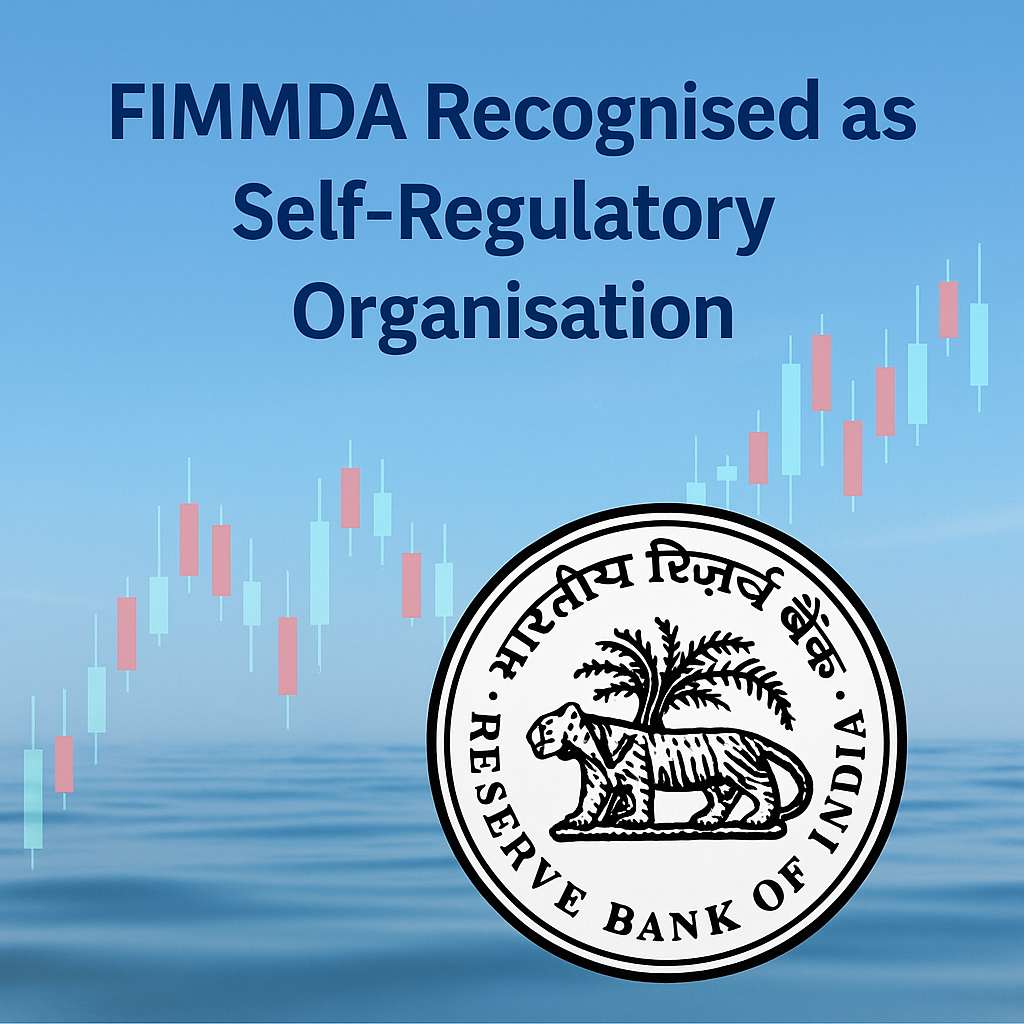
📅 May 9, 2025, Post 6: RBI Elevates FIMMDA to Self-Regulatory Status | Mains Essay / Target IAS-26 MCQs Attached: A complete Package, Dear Aspirants!
Discipline from Within: RBI Elevates FIMMDA to Self-Regulatory Status

NEWS DROP — PETAL 006
🗓️ Date: May 9, 2025
🏦 Thematic Focus: GS3 – Indian Economy | Financial Markets | RBI Reforms
🌿 Intro Whisper:
When market wisdom earns formal voice, regulation becomes not just a rule—but a shared responsibility.
🔍 Key Highlights:
- What’s in News:
The Reserve Bank of India (RBI) has officially recognised the Fixed Income Money Market and Derivatives Association of India (FIMMDA) as a Self-Regulatory Organisation (SRO)—transforming its status from an industry advisor to a regulatory enforcer.
🏛️ What is FIMMDA?
- Founded: 1998
- Members: Banks, insurance firms, primary dealers, financial institutions
- Scope:
➤ Fixed Income
➤ Money Markets
➤ Derivatives Markets - Past Role:
➤ Published benchmark rates
➤ Offered standard documentation
➤ Promoted best practices (without enforcement power)
⚙️ SRO Status – What’s Changed?
- Regulatory Authority:
➤ Can now enforce rules, not just recommend
➤ Penalise violations among members
➤ Ensure market discipline under RBI supervision - Governance Obligations:
➤ Must ensure fairness, transparency, and conflict-free decision making
➤ Treat all members equitably under its internal code - Grassroots Advantage:
➤ Possesses sector-specific expertise
➤ Faster resolution of niche market issues
🧾 Regulatory Framework Behind the Move
- RBI’s 2024 SRO Framework:
➤ Released in August 2024
➤ Defines eligibility criteria, responsibilities, and governance standards for SROs
➤ Aims to enhance regulatory depth without central micromanagement - FIMMDA’s Role Going Forward:
➤ Compliance monitor
➤ Market integrity enforcer
➤ RBI-aligned intermediary for smoother sectoral governance
🌍 Global Context and Market Impact
- Global Alignment: Many countries have SRO-led regulatory layers in financial markets
- Market Efficiency:
➤ Expected to reduce regulatory delays
➤ Improve member accountability
➤ Minimal disruption, maximum coordination anticipated
📘 GS Paper Mapping:
- GS Paper 3: Indian Economy | Financial Sector Reforms | Role of RBI
- GS Paper 2: Governance | Institutional Reforms
- Essay: “Self-Regulation in Financial Markets: Empowerment, Efficiency, and Ethical Capital”
🌠 Closing Thought:
Regulation works best not when it is imposed, but when it is embraced—from within the system it seeks to refine.
High Quality Mains Essay For Practice :
Word Limit 1000-1200
Self-Regulation in Financial Markets: Empowerment, Efficiency, and Ethical Capital
Introduction
Financial markets are among the most sensitive and complex systems in any economy. Their smooth functioning demands not only sound external regulation but also internal discipline. While central banks and government authorities set broad frameworks, the actual pulse of the market often beats within its own institutions. This is where self-regulatory organisations (SROs) step in—not to replace regulators, but to reinforce them.
The concept of self-regulation, rooted in the idea that industry players best understand their own complexities, offers a compelling model: one that balances empowerment with accountability, operational efficiency with ethical oversight. This essay explores how self-regulation enhances financial governance, boosts stakeholder trust, and shapes a resilient and future-ready market ecosystem.
What Is Self-Regulation?
Self-regulation refers to a system where an industry or sector sets and enforces its own standards, codes of conduct, and compliance mechanisms, often under the broader supervision of a statutory regulator. In financial markets, SROs typically include associations of market participants—such as stock exchanges, credit rating agencies, or fixed income trade bodies—tasked with monitoring member behavior, maintaining market integrity, and promoting best practices.
Recent developments in India, such as the Reserve Bank of India’s recognition of FIMMDA (Fixed Income Money Market and Derivatives Association of India) as an SRO, highlight a growing shift toward institutionalising this model.
Why Self-Regulation Matters
- Empowerment Through Specialised Knowledge Self-regulatory organisations are composed of industry insiders who possess technical expertise and frontline experience. This gives them a unique advantage in:
- Detecting emerging risks early
- Understanding product-level nuances
- Designing targeted codes of conduct and market conventions
- Efficiency in Monitoring and Compliance Traditional regulation can be heavy-handed and slow to adapt, especially in rapidly evolving financial environments. SROs act as decentralised enforcement bodies:
- Ensuring faster dispute resolution
- Reducing compliance bottlenecks
- Encouraging peer accountability
- Ethical Capital and Market Discipline In sectors where trust is the currency, ethical capital becomes as valuable as financial capital. Self-regulation enables:
- Peer pressure to uphold integrity
- Culturally embedded norms of ethical conduct
- Transparent enforcement through member participation
The Indian Context: Institutionalising SROs
India’s financial regulatory framework is primarily led by the RBI, SEBI, IRDAI, and PFRDA. While these institutions provide legal architecture, the inclusion of SROs adds granularity and agility to the system.
The RBI’s August 2024 framework for SRO recognition laid out clear criteria:
- Strong governance structures
- Transparent rule-making
- Mechanisms for member accountability
- Conflict-of-interest management
The recognition of FIMMDA as an SRO under this framework marked a critical milestone. It transitioned from an advisory body to an authority capable of:
- Enforcing rules
- Imposing penalties
- Acting as an industry intermediary with statutory legitimacy
Such reforms are aligned with global best practices in developed financial systems, such as FINRA (Financial Industry Regulatory Authority) in the United States.
Challenges in Self-Regulation
While the model holds great promise, it is not without limitations:
- Risk of Regulatory Capture
SROs, composed of industry members, may prioritize collective profit over public interest unless external checks are in place. - Conflicts of Interest
Balancing internal peer relationships with impartial enforcement can be difficult without clear governance firewalls. - Inequality of Influence
Larger institutions may dominate the rule-setting agenda, marginalizing smaller players or dissenting voices. - Lack of Public Transparency
Unlike statutory regulators, SROs may not be as accountable to Parliament, citizens, or the press.
These risks must be mitigated through strict alignment with a parent regulator like RBI or SEBI, clear audit trails, and periodic performance evaluations.
The Global Perspective
Globally, self-regulation has been instrumental in ensuring efficient capital market development:
- United States: FINRA oversees brokerage firms and exchange markets, complementing SEC oversight.
- United Kingdom: The London Stock Exchange operates under self-regulated norms while following Financial Conduct Authority guidelines.
- Japan & Singapore: Industry associations are entrusted with maintaining discipline in bond and foreign exchange markets.
India’s journey toward formalising SROs reflects this global learning, aiming for a “hybrid model” where autonomy is balanced with accountability.
The Ethical Argument
Beyond market mechanics, self-regulation is an ethical commitment. It reflects a maturing market culture where:
- Institutions take responsibility for systemic integrity
- Peer respect replaces regulatory fear
- Transparency is embedded, not enforced
This approach humanises financial governance, encouraging values like fairness, self-correction, and responsiveness to stakeholder concerns.
Conclusion
Self-regulation in financial markets is not a dilution of oversight—it is a deepening of responsibility. It empowers industry actors to lead with expertise, fosters operational efficiency, and builds a reservoir of ethical capital that statutory rules alone cannot generate.
As India aspires to become a global financial powerhouse, institutionalising self-regulation—rooted in trust, knowledge, and accountability—will be key. With proper checks and collaborative governance, self-regulatory organisations like FIMMDA can serve not just as market enforcers, but as market custodians.
Quote to Conclude:
“Markets run on numbers, but they thrive on trust. And trust, once self-regulated, becomes the most valuable asset of all.” — IAS Monk
Target IAS-26: Daily MCQs : May 9, 2025
📌 Prelims Practice MCQs
Topic:
MCQ 1: Type-1 — “How many of the above statements are correct?”
Consider the following statements regarding the recognition of FIMMDA as a Self-Regulatory Organisation (SRO):
1. FIMMDA was established in 1998 to represent institutions in fixed income, money market, and derivatives segments.
2. With SRO status, FIMMDA can now impose penalties on its members for regulatory violations.
3. RBI introduced the SRO recognition framework in August 2024.
4. FIMMDA was previously authorised to regulate and penalise member institutions.
How many of the above statements are correct?
A) Only two
B) Only three
C) All four
D) Only one
🌀 Didn’t get it? Click here (▸) for the Correct Answer & Explanation
✅ Correct Answer: B) Only three
🧠 Explanation:
1) Correct – FIMMDA was founded in 1998 for fixed income and derivative markets.
2) Correct – As an SRO, it now holds disciplinary authority.
3) Correct – The RBI released the SRO framework in August 2024.
4) Incorrect – FIMMDA previously acted as an advisory body without regulatory powers.
MCQ 2: Type-2 — Two-Statement Assertion
Consider the following statements:
1. FIMMDA’s elevation to SRO status allows it to enforce rules and impose penalties.
2. Self-Regulatory Organisations in India function independently without any RBI oversight.
A) Only 1 is correct
B) Only 2 is correct
C) Both are correct
D) Neither is correct
🌀 Didn’t get it? Click here (▸) for the Correct Answer & Explanation
✅ Correct Answer: A) Only 1 is correct
🧠 Explanation:
1) Correct – FIMMDA can now ensure compliance and penalise its members.
2) Incorrect – All SROs function under RBI oversight, especially in financial sectors.
MCQ 3: Type-3 — “Which of the above statements is/are correct?”
Consider the following statements about the regulatory framework for SROs in India:
1. The SRO framework by RBI defines eligibility, governance, and responsibilities of such bodies.
2. FIMMDA must avoid conflicts of interest while regulating its members.
3. The recognition of SROs aims to reduce regulatory burden and enhance decentralised governance.
4. FIMMDA can now independently print currency notes and set interest rates.
Which of the above statements are correct?
A) 1, 2 and 3 only
B) 1 and 4 only
C) 2, 3 and 4 only
D) All four
🌀 Didn’t get it? Click here (▸) for the Correct Answer & Explanation
✅ Correct Answer: A) 1, 2 and 3 only
🧠 Explanation:
• 1) Correct – The RBI’s 2024 framework outlines clear guidelines.
2) Correct – FIMMDA must follow high governance and neutrality standards.
3) Correct – SROs aim to supplement central regulation with industry-driven enforcement. 4) Incorrect – Only RBI can issue currency or set benchmark interest rates.
MCQ 4: Type-4 — Direct Factual Question
FIMMDA represents institutions involved in which of the following market segments?
A) Equity Markets
B) Commodity Markets
C) Fixed Income, Money Market, and Derivatives
D) Real Estate Sector
🌀 Didn’t get it? Click here (▸) for the Correct Answer & Explanation.
✅ Correct Answer: B) Commodity Markets
🧠 Explanation:
C) FIMMDA represents stakeholders in fixed income, money markets, and derivatives, including banks and primary dealers.

















